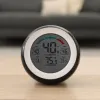If you’re wondering how best to brave the oppressive humidity we experience in the American South, you might have asked the question, “How does a dehumidifier work?”
As you may already know, the heat in this part of the country is only one source of discomfort. The other is the humidity. A dehumidifier, when properly installed and set up, can eliminate excess humidity and help you stay comfortable indoors.
But what’s the buzz about dehumidifiers all about? And why are they so useful in this climate zone? In this article, we’ll try to answer all of your questions about dehumidifiers, including which types make the most sense for your home.
What is a dehumidifier, anyway?
Good question! Let’s start with the basics. A dehumidifier is a machine designed to lower the humidity indoors.
If your home suffers from high humidity — a common problem in the South, in particular — you can set up a dehumidifier to lower the indoor relative humidity (RH) to the desired threshold. In many homes, RH ranges between 65% and 80% from spring through fall. With a dehumidifier, you can get the RH down to a much more comfortable 50% to 55%.
A dehumidifier is a device that’s designed to manage humidity beyond what your home’s air conditioner is capable of.
What does a dehumidifier do due to lower humidity?
When the dehumidifier is running, the humidity removal process unfolds as follows:
- A fan inside the dehumidifier brings air into the unit
- Inside the dehumidifier, moisture in the air is converted into condensation on the outside of an interior coil with the refrigerant inside of it; this is very similar to how an air conditioner works.
- Air leaves the dehumidifier with less moisture than it held when it entered the unit
- The humid air inside your home is gradually replaced with drier air leaving the dehumidifier
- The condensate that forms inside the dehumidifier drains into a container or, if you have a whole-house unit, into a drain line or pipe that channels it out of your house
Doesn’t my air conditioner already do that?
Yes and no. Your air conditioner is designed to do two things: lower temperature and lower humidity. On the hottest days of the year when it’s running a lot, it will usually do a pretty good job of keeping your home’s air dry and comfortable. The longer your AC runs, the more humidity it will remove.
But air conditioners are configured at a thermostat. Therefore, a typical AC only responds to changes in temperature. The fact that it also removes moisture is merely incidental.
Here’s an example. If you set the AC to 73 degrees, it will remove heat and humidity from your home until the indoor temperature drops to 73. You don’t get to tell the AC what RH percentage you want, so it might get the humidity down to a comfortable level… or not.
On the hottest days of the year, the AC in this example will run for long cycles. It might lower your humidity to 55% RH, which is great. But on warm-but-not-scorching days, it won’t run as frequently. It will always get your temperature down to 73 degrees, but it might only get your RH down to 70%. That’s still a pretty high level!
So on days when the AC doesn’t run for long cycles, it won’t remove much humidity. On mild days in the spring and fall, it might not run at all! Your home may be relatively cool, but still uncomfortably humid.
Your AC will only remove humidity to the extent you keep it running. During the fall when it’s 75 degrees outside and with 80% humidity, there’s a good chance you’ll be uncomfortable indoors.
Well, unless you’ve got a dehumidifier.
What kind of dehumidifier should I get?
For most homeowners, the choice will be between two different types of dehumidifiers:
- Standalone portable dehumidifiers
- Whole-house dehumidifiers
Standalone portable dehumidifiers
Standalone units are great for certain situations. If you just need to manage humidity in one room, they’re a good buy. You’ll see them in offices, waiting rooms, and so forth.
However, these small dehumidifiers also have drawbacks. In addition to having a limited coverage area, most will only dehumidify until the onboard tank is full of water. If you’re not around to manually empty the tank and reinstall it, the humidity will quickly creep back up to an uncomfortable level.
Do some standalone dehumidifiers have a drainage option? Yes. But you’d have to run a drain line out from your living room or wherever you put the unit. Most people don’t want a PVC pipe or drainage hose running through their living space. What’s more, standalone units typically only have 1-year warranties and aren’t designed to be serviced.
Whole-house dehumidifiers
Whole-house units don’t have the problems described above. They connect to your central HVAC system’s existing ductwork and drain all of the condensates into a pipe. Aside from changing the air filter periodically (usually twice per year) and having them serviced annually, they’re a set-it-and-forget-it device!
A whole-house dehumidifier also has a much better parts warranty, and a great labor warranty if it’s installed by a conscientious HVAC company, and — this part’s great — you never have to see it! Unlike a standalone unit that lives inside your house, makes noise, and generates a lot of heat inside your home, a whole-house unit is quiet, out of sight, and distributes the heat it produces across your ductwork so it’s not directly heating your living space.
The downsides of whole-house dehumidifiers? Well, they cost more than portable units, which is to be expected. But you also have to be sure that you receive a proper whole-house dehumidifier installation. In some cases, people will have an HVAC company install their dehumidifier only to be disappointed in its performance. More often than not, this isn’t because of the unit itself. It’s because of how it was installed.
At PV Heating, Cooling & Plumbing, we follow very specific installation procedures for dehumidifiers. Because of how we install them, you can feel confident that they’ll keep your humidity at a comfortable level all year round!
Now that you know how a dehumidifier works, let’s keep your home’s humidity in check!
If you’re ready to improve humidity management in your Atlanta area home, PV Heating, Cooling & Plumbing can help! Our experienced team will analyze your home, identify opportunities to improve humidity management and help you decide whether a whole-house dehumidifier makes the most sense.
Just give us a call at (404) 798-9672 or schedule a consultation online!






